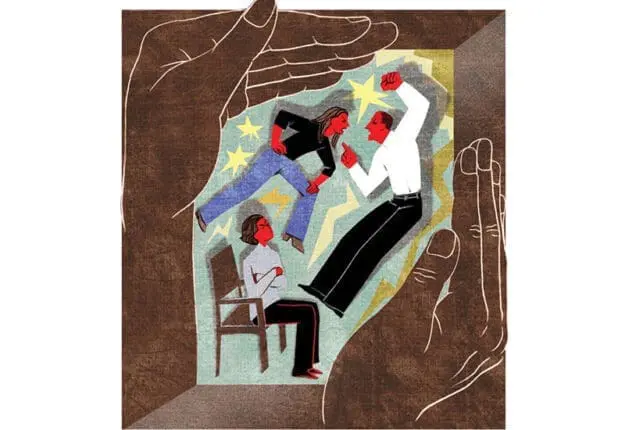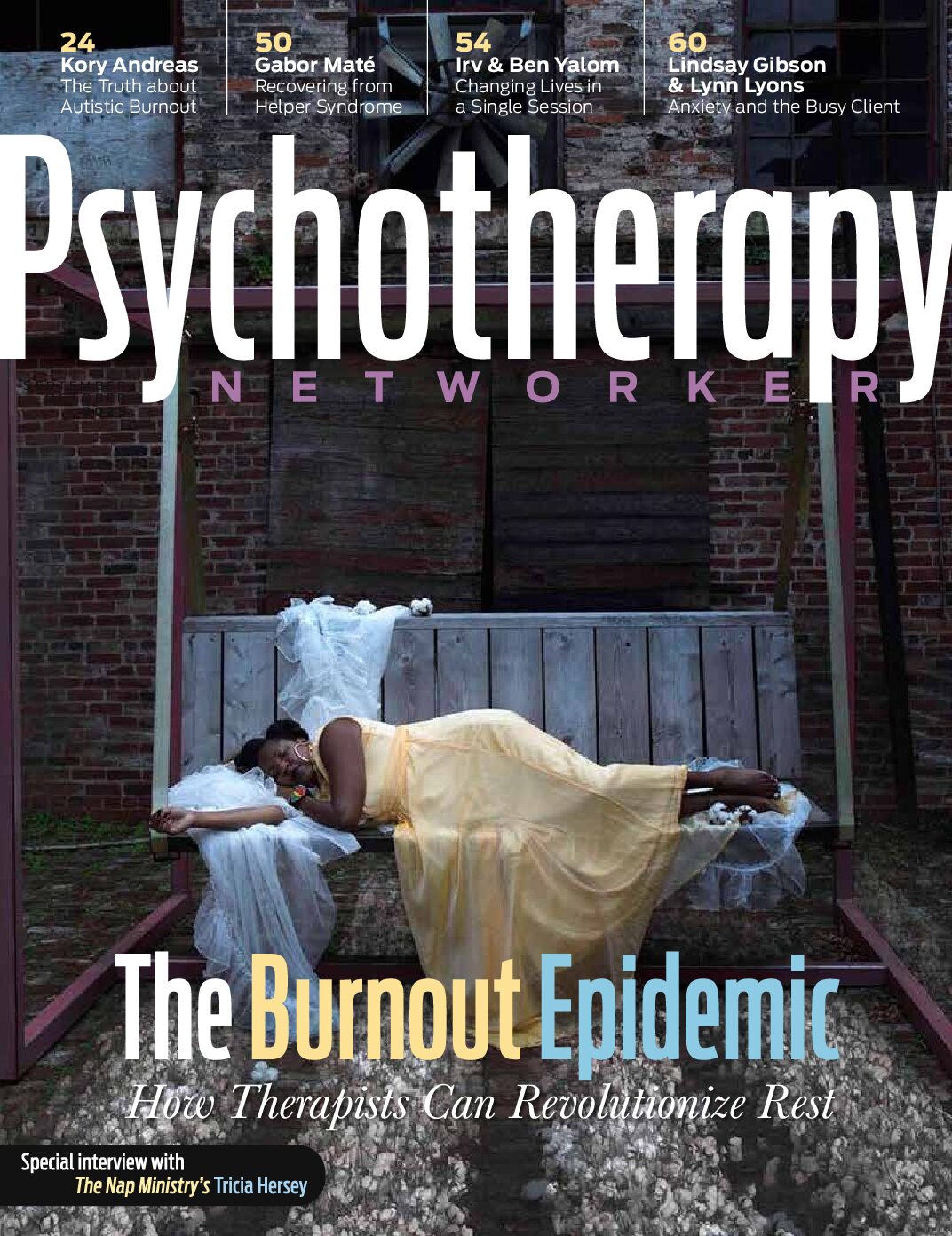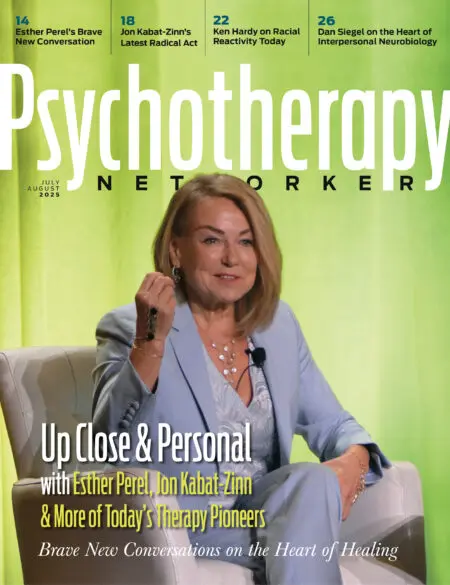Sarah’s arrest came as a complete shock to her parents, Edward and Ellen. True, the 15-year-old had experienced difficulties for many years. Adopted when she was 2, she showed oppositional behaviors when she was 6, was placed in a special section at her school for kids with behavioral problems when she was 10, and had a long history of different counselors and psychologists. Since starting high school, she’d begun running with the wrong crowd and started smoking dope. Still, with all the therapy through the years focused on helping her learn to control her anger, Edward and Ellen thought the worst was behind them. They certainly didn’t expect a cop at the door saying that their daughter had been caught riding in a car with a group of teens who’d robbed an electronics store. This was the “last straw” for her parents, who were now considering whether to send her to a residential treatment facility.
When Sarah and her parents came to the first session, they were tense and upset. My first question—“Can you tell me what goes on between the three of you?”—was immediately met with an angry outburst from Sarah’s father, a teacher at the local high school. “I’m done with this! You need to talk with her; we’ve been through enough!” he yelled. Sarah’s mother, said, “Ed, stop it! I am so tired of all this.”
Sarah immediately stood up and yelled back, “This is exactly why I didn’t want to come here today! I’m not going to say anything!” before sitting down with a sullen look on her face. Meanwhile, Sarah’s mom, Ellen, sat silent, distant, and detached.
Edward stood, moved toward Sarah, and in a quiet, but seething voice said, “We’re done. I see no way out—you’re out.” He turned to me and in the same subdued, angry tone said, “We’ve already talked with a residential treatment program, and we decided that if this didn’t work, we’d send her. We want your help in deciding which one is best.”
Despite long experience working with families, as well as researching and writing about working with angry families, I still find myself surprised and a little scared by explosive outbursts like this. In the first moments with this family, I felt caught between Edward’s request, Sarah’s desire to be heard, and the strong feelings in the room.
Like many therapists, I want to take action immediately to calm volatile emotions and try to make a difference. But what could I do here?
Finding a Clinical Road Map
In training, I learned all the psychotherapy theories, but in actual practice, theory rarely helped me know what action to take in any given moment, particularly when family members are openly raging at each other. Over the years, I’ve found that I’ve needed a solid, research-backed clinical model, which would guide me in sessions and keep me grounded during conflicted family interactions, and be flexible enough to allow me to draw on my intuition, creativity, and sense of the client.
The one I use, based on 30 years of research on the most effective interventions with delinquent and violent juveniles and their families, is Functional Family Therapy (FFT). Like other models, it provides a framework for conceptualizing the case, focusing attention on significant aspects of the client’s dilemma, relational family patterns, and history, and more important, a kind of “clinical GPS” system. It not only shows a way through rough, unmarked territory, but allows you to update decision points and recalibrate the therapy to fit changing circumstances and unexpected developments.
The core notion of FFT is that there’s a beginning, a middle, and an end to the therapeutic change process, which correlates with three distinctly defined phases of treatment: engagement/motivation, behavior change, and generalization. Each has specific goals and requires specific therapeutic skills.
I knew I needed to act quickly to get this family engaged and motivated before the session ran away without me. The clinical GPS that FFT provides told me that the first thing I needed to do to achieve the primary goal of phase 1—engagement and motivation—was to use the event in the room to reduce negativity and blame, and create a family focus. Also, I had to do it in a way that “matched” the family’s style.
The event wasn’t hard to find, so I said: “I’ve been told that all of you were very reluctant to come today, and—as you’ve reiterated—that you’re considering having Sarah live somewhere else. My guess is that what just happened is a reflection of your struggle. I respect and appreciate your honesty, but I need your assistance. Can you help me understand what goes on between the three of you that ends up with this level of discouragement?”
The initial question represented an important core principle of FFT: presenting problems are relational. The goal of the question was to pull them out of an emotional pattern that put the blame on Sarah and shift the focus to the entire family.
Sarah was the first to respond. “What a stupid question! Can’t you see, this is what I have to deal with every day?” she said belligerently. Ellen sighed and turned away again, while Edward said to me, “Now you can see why we can’t take it anymore—she’s so disrespectful.”
“It was a stupid question,” I quickly responded to Sarah. “And it comes from not really knowing how things work in this family. I may never completely understand your feelings or the struggle your parents have in trying to protect you, but what I do know is that the anger you feel gets misunderstood as your unwillingness to try, to listen, and to be respectful. My guess is that what looks to be anger is really fear—fear of losing them.” Before her parents could respond, I turned to them, saying, “And it’s probably not a lot different for the two of you. The anger behind the decision to send her away is less about wanting her gone than about the fear that you won’t be able to protect her and help her in the way your heart tells you that you should.” Again, talking fast before anyone could speak, “That’s why I’m so curious about what happens here.”
Reframing—A Therapeutic Martial Art
This kind of intervention is called a “relational reframing,” a term coined by my colleague Jim Alexander and me. This dynamic form of reframing is really the “judo” of this therapy. As in judo, the therapist “moves toward,” using the powerful emotional momentum already present in the room, to shift the direction of therapy and promote new ways for clients to see themselves and their problems.
Just like judo, reframing happens through a series of interactions, not a single intervention. With Sarah and her family, I tried several different ways in the conversation to redirect their anger toward the theme of the hurt behind the anger. For example, later, when Sarah’s father said he’d exploded with anger about a situation, Sarah gave a sharp, loud, derisive laugh. She then said heatedly that when her father, or anybody else, yelled at her, “It just makes me crazy!”
Reframing again, I suggested that Sarah’s apparently disrespectful laugh was a form of assertiveness—a requirement on the street, where she and her peers thought of themselves as tough. I thus reframed her aggressive response to her father as difficulty hearing her father as a parent, rather than as a challenging peer. Then I said to Sarah that I heard her defiance and volatile anger as pain and frustration, because her father didn’t know how to reach her except by yelling.
At that, Sarah began to cry and, through her tears, said that she’d lost her parents once (her biological parents), and she wasn’t going to lose anyone else. Sobbing, she said she knew her parents saw her as a bad kid, but inside, she was a girl with a heart.
By framing the parents’ behavior as the expression of loss, bafflement, and hurt, as well as a heartfelt desire to protect their daughter, I gave myself room to suggest that while their motives and intentions were noble, their reactions to Sarah weren’t always helpful. In other words, I could help them acknowledge their part in the problem, frame it in a way that wouldn’t make them defensive, and start to build a family alliance. This, in turn, would create a safe environment, in which all could talk about difficult issues without reverting to mutual accusations.
During the first session, the family went round and round in cycles of blame, counterblame, and “it’s-off-to-residential-treatment-with-you,” so as the session progressed, I had to find new relational reframes to promote a sense of the family unit.
By the second session, the mutual blame and antipathy had palpably softened. I finally had the sense that the family was engaged, motivated, and in alliance with each other—and with me—when the issue of placement seemed to vanish from the conversation and all three began talking in terms of “we,” rather than attacking each other. Best of all, we crafted a family-focused definition of the problem together.
When There’s More to the Story
This rosy scenario abruptly collapsed at the beginning of the third session, when all three walked in with grim looks on their faces and sat down in angry, hostile silence. I could immediately feel dread in the pit of my stomach—were we back to square one? As it turned out, Sarah and her parents had had another major fight the day before, and the alliance had clearly broken down. Following the principles of FFT, I moved toward the black mood in the room and said, “The silence and tension I feel tells me that there’s more going on . . . ?”
This time, it was Ellen who spoke first. “I wasn’t going to come here today. I have to be honest with you, after our first visit, I was skeptical about the idea that we were all stuck in the same place. At home, I must say, I did feel different, and over the last two weeks, I even began to feel more hopeful. But yesterday’s fight convinced me that we need more in-depth help. We think Sarah needs medication. Now that things are a little better, maybe we can get the help we need.”
Then Ellen dropped her bomb. There were things about Sarah’s history I didn’t know, she said. By 13, Sarah had started to stick her finger down her throat, scratch herself, and throw up blood on a fairly regular basis. Fearing a more serious psychiatric problem, Edward and Ellen had taken Sarah to multiple psychiatrists and psychologists through her middle-school years. She’d received various diagnoses, including social anxiety disorder and bipolar disorder. Different doctors had prescribed different medications, but she’d refused to comply with any drug regimen. Each time, her refusal to take the meds, like her school problems and other behavioral issues, became the source of serious family conflicts.
When I heard about the self-harm, the psychiatric diagnoses, and the multiple prescriptions, I was both dismayed and disappointed. How did I miss this? I wondered. Had I gone too fast with this family? Once again, it was the FFT model that helped keep me from being pulled into a fearful, reactive position based on Sarah’s history. FFT’s core principle—that presenting problems are always relational—helped me see that Sarah’s history had shaped the family’s current interactional patterns. Now, when Sarah acted rebellious or oppositional, as she had the previous day, her mother panicked, frightened that her daughter was once again slipping back into a pattern of self-harm. But this was Ellen’s issue, not Sarah’s, and neither Ellen’s fear of the past nor Sarah’s misbehavior indicated that I should change the direction of therapy.
Turning to Ellen, I said, “This is very important. I think I finally understand why you’re so afraid. You’ve spent many years being afraid about what might happen to Sarah if you didn’t find a way to protect her. Now I understand why yesterday’s fight felt to you powerful enough to overshadow the big changes happening between the three of you over the last weeks. Also, I can see what your biggest challenge will be as we move forward: your fear is so big that it’s constantly with you. In fact, if I were to guess, I’d think this helps explain this fight. When your fear emerges, Ed and Sarah feel it and things quickly escalate, and the situation once again looks like it did when you first came here.”
Sarah, clearly angry, started to respond, but I stopped her and focused the conversation on her mother. Ellen sat silently for a moment, and then began to cry. “I just want her to be OK,” she said.
I responded to Ellen, “This feeling—the fear and hurt that you and Edward might lose her and she’d lose you—is the source of the struggle among the three of you, but it gets lost in the fighting, which is how each of you tries to find a way out of the struggle.” Hearing this, Sarah became quiet and the anger left her face.
This was a turning point for me. It would have been so easy to go back and join the family in feeling stuck. But framing Ellen’s concern as her own challenge actually helped us move to the second phase of therapy—behavior changes to develop competencies that would serve a protective function for the family.
Encouraging and Expanding New Behaviors
Behavioral approaches to families like Sarah’s usually focus entirely on communication, problem-solving, negotiating, conflict management, and parenting, but I began by teaching the family how to interrupt escalating interactions that typically occurred when Sarah came home in the evenings. I noted that the family could prevent or interrupt escalations by first negotiating limits to when and how long Sarah would be out on the street, and then learning how to manage conflict when she came home.
The perfect opportunity presented itself when, just before the fourth session, the family came in upset because, several nights before, Sarah had come home much later than she’d agreed, without letting her parents know where she was or when she’d return. When she finally did get home, the typical explosion occurred between father and daughter. Pointing out that this was a common struggle among them, I said, “I want to ask you to try something different in your discussion of this event. Sarah, this seems like an opportunity for you and your parents to negotiate a time to come home so they’re not worried and scared. Just trying to negotiate a coming-home plan might also help all of you identify a common set of rules in other areas, so you know what to expect from each other.”
The specific agreement negotiated by a family is much less important than helping them follow a process that develops and builds negotiation competence. At this point in the behavior change phase of FFT, I’m not mediating between family members or helping them forge acceptable agreements to solve specific problems, but coaching them in how to competently negotiate their own agreements.
In the three behavior change sessions with this family, focusing on their most salient presenting issue (escalation of anger around Sarah’s return home), they practiced the negotiation and conflict-management strategies I’d taught them. The goal was to help them tailor these skills to multiple situations as they came up. During the sixth session, we focused on the many ways in which the strong emotion generated by their volcanic reactions was likely to pull them back into old patterns. I reframed their discouragement when additional struggles came up—like Sarah’s continued drug use—and helped them generalize what they’d learned.
Seeing the Results of FFT
By now, the practice of negotiating issues together had helped the family internalize a sense of themselves as part of an alliance: Sarah was no longer regarded as a source of their difficulties: her problems were their problems, and vice versa. With this new, expanded sense of themselves as an integrated family unit, a team—along with their generalizable skills at working through problems together—they could become more proactive at addressing other issues in new ways. For example, I initiated a conversation about Sarah’s school and learning difficulties, and the parents, on their own, sought out the resources of the mental health center to seek a psychiatric consultation. The new psychiatrist diagnosed Sarah with an attention deficit problem—definitively ruling out bipolar disorder—and prescribed a medication, which Sarah willingly took. In addition, through the same mental health center, the family identified a specialized learning environment for Sarah with smaller class sizes, where she enrolled. The fact that the family found and made use of these resources on their own represented a milestone for them and indicated that the goals of the generalization phase had been accomplished.
After six months, during a follow-up appointment, I discovered that Sarah had been arrested once for a minor curfew violation. While discouraging, this represented a relatively small problem, given Sarah’s history. In addition, the father and Sarah had experienced a few explosions, but generally, the family was able to reapply the skills they’d learned through FFT to get back on track. What’s more important, the family had successfully managed setbacks by using the conflict-management skills they’d learned during the behavior-change phase of treatment. Sarah was successfully meeting the requirements of the special school program, coming home close to the expected time, and taking her medication as prescribed. Better still, despite ongoing challenges, her parents hadn’t threatened to have her removed from the home: they’d become a united family, fully committed to one another.
Case Commentary
By Martha Straus
Thomas Sexton presents a model for conducting brief family treatment with a complex case, and demonstrates some deft and inspired strategies for diffusing anger, reframing conflict, and forming working alliances in therapy. By delving beneath displays of aggression and rage toward more vulnerable feelings of fear, abandonment, hurt, and confusion, he creates connections with the different family members, and then provides them with skills for negotiating and managing conflict.
I have three questions about this interesting work. First, I wonder about the decision to begin treatment with the entire family when the situation is so volatile. In my experience, it’s often useful to have a first session with parents to hear about their concerns and expectations for therapy. Without the reluctant and reactive adolescent in the room, I’d opt for a careful genogram, a detailed developmental history, and begin to establish an adult agenda going forward.
Indeed, with adolescents adopted as toddlers, there’s usually a relevant back story that concerns the parents’ marriage, the decision and circumstances surrounding the adoption, and the legacy of early attachment trauma that helps explain—and reframe—the oppositional coping strategies employed by young people like Sarah. Parents benefit from being able to describe freely what they’ve gone through. As in Sexton’s case, these families have often had numerous prior interventions. So wouldn’t it have been useful to clarify how this one would be different, to make manifest the goals of FFT, to give Edward and Ellen a distinct voice?
In a similar vein, I’m curious about the marriage. I wonder why this intervention overlooked their relationship. I was concerned, for example, that Ellen seemed so passive and withdrawn, while Edward was so furious at that first meeting. Sexton was skilled at containing and shaping the session, but he risked more than I would have; with residential placement and possible adoption disruption on the line, I’d have worried about the couple’s relationship, too.
Was the function of Sarah’s acting out an indicator of some other issues that didn’t (and shouldn’t) involve her? For example, was her fear of losing her adoptive parents an expression of sensitivity to a different threat—of divorce, for instance? Was Edward’s anger a problem for Ellen, too? Why was Ellen so vigilant about Sarah’s self-harm that the fear about it was “her issue?” Why wasn’t it Edward’s concern, too? Presenting problems are surely relational, as Sexton wisely notes, and defiant adolescents often point the way to other relationship work that needs to be done.
My final musing is about what was really effective in this clearly effective intervention. There’s a robust literature suggesting that technique accounts for about one percent of the variance explaining why clients get better in treatment. Sexton’s adherence to his FFT model is important, of course, but his belief in this approach and the hope he held for this family are possibly more important than the specific tasks he describes.
I wondered about the qualities Sexton possesses that make him a gifted counselor. He appears to view his role as one of teacher, coach, and facilitator, as much as therapist. However, his sensitive attention to process, underlying affect, and mutual desire for closeness and connection suggests that he’s doing psychotherapy—with a family who really believed he could help them. Although he gives lots of credit for his success to the “GPS” provided by the FFT model, I imagine his success is more about his close attention to alliance, his dexterity with interpretation, and his ability to create and hold a suitably resonant frame for this troubled family.
Author’s Response
We all follow models when we work with clients. Some therapists’ models are implicit. For me, an explicit and specific model with good evidence that it can work is the core of what allows me to be a creative therapist. In fact, I find that my therapeutic creativity only can exist within the structure of a model. Across disciplines and tasks, researchers are discovering the secret behind creativity is based on having a tested and reliable structure and hours of practice for complex tasks to become automatic enough that we can work in, and between, the structure.
The most recent psychotherapy research echoes these findings—some ways of working are better than others, particularly when it comes to problem adolescents and their families. But, as Martha Straus points out, this work suggests that there’s more to it than a model. In fact, the key ingredient in the success of effective models of practice is following the model with creativity.
This is what FFT provides me: the structure to be creative in a way that lets me go beyond my own limitations and the relational “pull” in the room to provide a pathway for successful change. In this case, it might be easier to see the parents and youth individually, yet the principles of FFT show how separating parents from youth or using a genogram does little to give voice to the parents or the youth, because it may actually promote the negativity and blaming that have the family stuck. Unlike Straus, I don’t worry about Ellen’s quietness or the need to let the parents tell me what they want without their adolescent present. The FFT model is built on the notion of respect. That respect goes so far as to allow people their quietness. By taking a conjoint approach, we hope to bring the family’s relational activities into the room and give everyone a voice, so that we can intervene in a way that’s personal, relevant, and real.
FFT lets me to move beyond my therapeutic habits, values, and potential discomfort with conflict. The model helps me respect clients for who they are and push myself to take advantage of the opportunities in the room and, thus, facilitate changes that have a powerful impact. So, while I appreciate Straus’s complimentary view of my therapeutic skills, I’d suggest that it’s the model that gives me the map to follow. This reliable and tested approach is the structure within which my creativity can exist. Good practice and sound models are like all dialectics— inseparable.
Illustration © Sally Wern Comport
Thomas Sexton
Thomas Sexton, PhD, one of the developers of Functional Family Therapy, is a professor in the Department of Counseling Psychology at Indiana University. His books include The Handbook of Family Therapy and Functional Family Therapy in Clinical Practice.
Martha Straus
Martha Straus, PhD, a professor in the Department of Clinical Psychology at Antioch University New England, is the author of No-Talk Therapy for Children and Adolescents, Adolescent Girls in Crisis, and Treating Traumatized Adolescents: Development, Attachment, and the Therapeutic Relationship.














